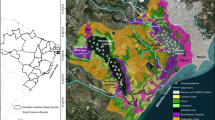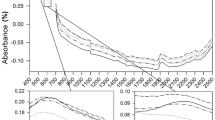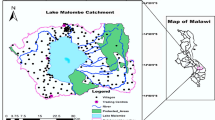Abstract
Nuisance cyanobacterial blooms degrade water resources through accelerated eutrophication, odor generation, and production of toxins that cause adverse effects on human health. Quick and effective methods for detecting cyanobacterial abundance in drinking water supplies are urgently needed to compliment conventional laboratory methods, which are costly and time consuming. Hyperspectral remote sensing can be an effective approach for rapid assessment of cyanobacterial blooms. Samples (n = 250) were collected from five drinking water sources in central Indiana (CIN), USA, and South Australia (SA), which experience nuisance cyanobacterial blooms. In situ hyperspectral data were used to develop models by relating spectral signal with handheld fluorescence probe (YSI 6600 XLM-SV) measured phycocyanin (PC in cell/ml), a proxy pigment unique for indicating the presence of cyanobacteria. Three-band model (TBM), which is effective for chlorophyll-a estimates, was tuned to quantify cyanobacteria coupled with the PC probe measured cyanobacteria. As a comparison, two band model proposed by Simis et al. (Limnol Oceanogr, 50(11): 237–245, 2005; denoted as SM05) was paralleled to evaluate TBM model performance. Our observation revealed a high correlation between measured and estimated PC for SA dataset (R 2 = 0.96; range: 534–20,200 cell/ml) and CIN dataset (R 2 = 0.88; range: 1,300–44,500 cell/ml). The potential of this modeling approach for imagery data were assessed by simulated ESA/Centinel3/OLCI spectra, which also resulted in satisfactory performance with the TBM for both SA dataset (RMSE % = 26.12) and CIN dataset (RMSE % = 34.49). Close relationship between probe-measured PC and laboratory measured cyanobacteria biovolume was observed (R 2 = 0.93, p < 0.0001) for the CIN dataset, indicating a stable performance for PC probe. Based on our observation, field spectroscopic measurement coupled with PC probe measurements can provide quantitative cyanobacterial bloom information from both relatively static and flowing inland waters. Hence, it has promising implications for water resource managers to obtain information for early warning detection of cyanobacterial blooms through the close association between probe measured PC values and cyanobacterial biovolume via remote sensing modeling.








Similar content being viewed by others
References
Bastien C, Cardin R, Veilleux É, Deblois C, Warren A, Laurion I (2011) Performance evaluation of phycocyanin probes for the monitoring of cyanobacteria. J Environ Monit 13:110–118
Codd GA, Morrison LF, Metcalf JS (2005) Cyanobacterial toxins: risk management for health protection. Toxicol Appl Pharmacol 203:264–272
Dall'Olmo G, Gitelson AA (2005) Effect of bio-optical parameter variability on the remote estimation of chlorophyll-a concentration in turbid productive waters: experimental results. Appl Opt 44:412–422
Dekker AG (1993) Detection of the optical water quality parameters for eutrophic waters by high resolution remote sensing. PhD thesis, Free University, Amsterdam, The Netherlands
Dekker AG, Malthus TJ, Syhan E (1991) Quantitative modeling of inland water quality for high resolution MSS system. IEEE T Geosci Remote 29:89–95
Gitelson AA, Schalles JF, Hladik CM (2007) Remote chlorophyll-a retrieval in turbid, productive estuaries: Chesapeake Bay case study. Remote Sens Environ 109:464–472
Gitelson AA, Dall’Olmo G, Moses W, Rundquist DC, Barrow T, Fisher TR, Gurlin D, Holz J (2008) A simple semi-analytical model for remote estimation of chlorophyll-a in turbid waters: validation. Remote Sens Environ 112:3582–3593
Gitelson AA, Gurlin D, Moses WJ, Barrow T (2009) A bio-optical algorithm for the remote estimation of the chlorophyll-a concentration in case 2 waters. Environ Res Lett 4:045003
Guanter L, Ruiz-Verdú A, Odermatt D, Giardino C, Simis S, Estellés V, Heege T, Antonio J, Domínguez-Gómez MJ (2010) Atmospheric correction of ENVISAT/MERIS data over inland waters: validation for European lakes. Remote Sens Environ 114:467–480
Huisman J, Matthijs HCP, Visser PM (2005) Harmful cyanobacteria. Springer, Dordrecht, Netherlands
Hunter PD, Tyler AN, Presing M, Kovacs AW, Preston T (2008) Spectral discrimination of phytoplankton colour groups: the effect of suspended particulate matter and sensor spectral resolution. Remote Sens Environ 112:1527–1544
Hunter PD, Tyler AN, Gilvear DJ, Willby NJ (2009) Using remote sensing to aid the assessment of human health risks from blooms of potentially-toxic cyanobacteria. Environ Sci Technol 43:2627–2633
Hunter PD, Tyler AN, Carvalho L, Codd GA, Maberly SC (2010) Hyperspectral remote sensing of cyanobacterial pigments as indicators for cell populations and toxins in eutrophic lakes. Remote Sens Environ 114:2705–2718
Kosten S, Huszar VM, Becares E, Costa LS, Donk EV, Hansson L, Jeppesen E, Kruk C, Lacerot G, Mazzeo N, Meester L, Moss B, Lurling M, Noges T, Romo S, Scheffer M (2012) Warmer climates boost cyanobacterial dominance in shallow lakes. Glob Chang Biol 18:118–126
Li L, Sengpiel RE, Pascual DL, Tedesco LP, Wilson JS, Soyeux E (2010) Using hyperspectral remote sensing to estimate chlorophyll-a and phycocyanin in a mesotrophic reservoir. Int J Remote Sens 31(15):4147–4162
Matthews MW, Bernard S, Winter K (2010) Remote sensing of cyanobacteria-dominant algal blooms and water quality parameters in Zeekoevlei, a small hypertrophic lake, using MERIS. Remote Sens Environ 114:2070–2087
McQuaid N, Zamyadi A, Prevost M, Bird DF, Dorner S (2011) Use of in vivo phycycyanin fluorescence to monitor potential microcystin-producing cynobacterial biovolume in a drinking water source. J Environ Monit 13:455–463
Mille DF, Baker MC, Tucker CD, Vinyard BT, Dionigi CP (1992) High resolution airborne remote sensing of bloom-forming phytoplankton. J Phycol 28:281–290
Moses WJ, Gitelson AA, Berdnikov S, Saprygin V, Povazhnyi V (2012) Operational MERIS-based NIR-red algorithms for estimating chlorophyll-a concentrations in coastal waters—the Azov Sea case study. Remote Sens Environ 121:118–124
Ntuli F, Kuipa PK, Muzenda E (2011) Designing of sampling programmes for industrial effluent monitoring. Environ Sci Pollut Res 18:479–484
Paerl HW, Fulton III RS (2006) Ecology of harmful cynobacteria. In: Graneli E, Turner J (eds.) Ecology of Harmful Marine Algae. Springer, Berlin, pp 95–107
Paerl HW, Huisman J (2008) Climate—blooms like it hot. Science 320:57–58
Petaloti C, Voutsa D, Samara C, Sofoniou M, Stratis I, Kouimtzis T (2004) Nutrient dynamics in shallow lakes of Northern Greece. Environ Sci Pollut Res 11:11–17
Randolph K, Wilson J, Tedesco LP, Li L, Pascual DL, Soyeux E (2008) Hyperspectral remote sensing of cyanobacteria in turbid productive water using optically active pigments, chlorophyll a and phycocyanin. Remote Sens Environ 112:4009–4019
Ruiz-Verdú A, Simis SG, de Hoyos C, Gons HJ, Peña-Martinez R (2007) An evaluation of algorithms for the remote sensing of cyanobacterial biomass. Remote Sens Environ 112:3996–4008
Sarada R, Pillai MG, Ravishanker GA (1999) Phycocyanin from Spirulina sp.: influence of processing of biomass on phycocyanin yield, anaylsis of efficacy of extraction methods and stability studies on phycocyanin. Process Biochem 34:795–801
Schaeffer BA, Hagy JD, Conmy RN, Lehrter JC, Stumpf RP (2012) An approach to developing numeric water quality criteria for coastal waters using the SeaWiFS Satellite data record. Environ Sci Technol 46:916–922
Schalles JF, Yacobi YZ (2000) Remote detection and seasonal patterns of phycocyanin, carotenoid, and chlorophyll pigments in eutrophic waters. Arch Hydrobiol Spec Issues Adv Limnol 55:153–168
Schmidt S (2003) International standardization of water analysis basis for comparative assessment of water quality. Environ Sci Pollut Res 10(3):183–187
Simis GH, Peters SW, Gons HJ (2005) Remote sensing of the cyanobacterial pigment phycocyanin in turbid inland water. Limnol Oceanogr 50(11):237–245
Simis SG, Ruiz-Verdú A, Domínguez-Gómez AJ, Peña-Martinez R, Peters SW, Gons HJ (2007) Influence of phytoplankton pigment composition on remote sensing of cyanobacterial biomass. Remote Sens Environ 106:414–427
Song KS, Li L, Li S, Tedesco L, Li LH, Hall B (2012a) Hyperspectral remote sensing of total phosphorus (TP) in three central Indiana water supply reservoirs. Water Air Soil Pollut 223(4):1481–1502
Song KS, Li L, Li S, Tedesco L, Hall B, Li ZC (2012b) Hyperspectral retrieval of phycocyanin in potable water sources using genetic algorithm-partial least squares (GA–PLS) modeling. Int J Appl Earth Obs 18:368–385
Song KS, Li L, Tedesco LP, Li S, Clercin AN, Hall B, Li ZC, Shi K (2012c) Hyperspectral determination of eutrophication for a water supply source via genetic algorithm-partial least squares (GA–PLS) modeling. Sci Total Environ 426:220–232
Stumpf RP, Wynne TT, Baker DB, Fahnenstiel GL (2012) Interannual variability of cyanobacterial blooms in Lake Erie. PLoS One 7(8):e42444
Sun J, Liu D (2003) Geometric models for calculating cell biovolume and surface area for phytoplankton. J Plankton Res 25:1331–1346
Tedesco L, Clercin N (2011) Algal ecology, cyanobecteria toxicity and secondary metabolites production of the three eutrophic drinking water supply and recreational use reservoirs in Central Indiana. 2010 Research Project Final Report, pp 25–29
Vincent RK, Qin X, McKay RML, Miner J, Czajkowski K, Savino J, Bridgemanet T (2004) Phycocyanin detection from LANDSAT TM data for mapping cyanobacterial blooms in Lake Erie. Remote Sens Environ 89:381–392
Wynne TT, Stumpf RP, Tomlinson M, Warner RA, Tester PA, Dyble JJ, Fahnenstiel GL (2008) Relating spectral shape to cyanobacterial blooms in the Laurentian Great Lakes. Int J Remote Sens 29(12):3665–3672
Wynne TT, Stumpf RP, Tomlinson MC, Dyble J (2010) Characterizing a cyanobacterial bloom in western Lake Erie using satellite imagery and meterological data. Limnol Oceanogr 55(5):2025–2036
Zamyadi A, McQuaid N, Prévost M, Dorner S (2012) Monitoring of potentially toxic cyanobacteria using an online multi-probe in drinking water sources. J. Environ Monit 14:579–588
Acknowledgments
This work was financially supported by the CAS/SAFEA International Partnership Program for Creative Research Teams and a NASA grant to Dr. Lin Li (NNG06GA92G). Additional financial support is provided by the Natural Science Foundation of China (No. 41171293). Field data in three Indiana drinking water sources were collected with the capable assistance of Mike Stouder from the Department of Earth Sciences and Center for Earth and Environmental Science, IUPUI. Data from South Australia is financially supported by Veolia Water LLC and the Central Indiana Water Resources Partnership, and South Australia Water. We also acknowledge the contribution by Tingting Zhang and Linhai Li for the field sampling and laboratory analyses.
Author information
Authors and Affiliations
Corresponding author
Additional information
Responsible editor: Philippe Garrigues
Rights and permissions
About this article
Cite this article
Song, K., Li, L., Tedesco, L. et al. Remote estimation of phycocyanin (PC) for inland waters coupled with YSI PC fluorescence probe. Environ Sci Pollut Res 20, 5330–5340 (2013). https://doi.org/10.1007/s11356-013-1527-y
Received:
Accepted:
Published:
Issue Date:
DOI: https://doi.org/10.1007/s11356-013-1527-y




